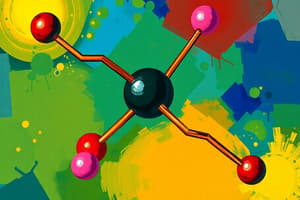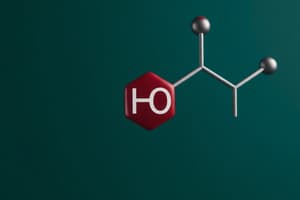Podcast
Questions and Answers
What is the correct naming convention for a monosubstituted benzene compound with the formula C6H5Br?
What is the correct naming convention for a monosubstituted benzene compound with the formula C6H5Br?
- bromophenol
- phenylbromide
- bromobenzene (correct)
- bromocyclohexane
Which description is true for a compound that is classified as a phenyl-substituted alkane?
Which description is true for a compound that is classified as a phenyl-substituted alkane?
- It refers to a monosubstituted benzene.
- The substituent is a phenyl group attached to a larger alkane. (correct)
- It cannot have any additional substituents on the benzene ring.
- It must contain fewer than six carbons in the substituent.
What is the prefix used to indicate a 1,2 substitution on a benzene ring?
What is the prefix used to indicate a 1,2 substitution on a benzene ring?
- para
- di
- meta
- ortho (correct)
When naming disubstituted benzenes, which substitution pattern represents a 1,4 relationship?
When naming disubstituted benzenes, which substitution pattern represents a 1,4 relationship?
When naming a benzene compound, how should the substituents be listed?
When naming a benzene compound, how should the substituents be listed?
Which of the following statements about monosubstituted benzenes is incorrect?
Which of the following statements about monosubstituted benzenes is incorrect?
What is the correct name for the C6H5CH2- group?
What is the correct name for the C6H5CH2- group?
In a benzene ring with more than two substituents, what is the first step in determining the IUPAC name?
In a benzene ring with more than two substituents, what is the first step in determining the IUPAC name?
What distinguishes benzene from the corresponding cycloalkane in terms of hydrogen atoms?
What distinguishes benzene from the corresponding cycloalkane in terms of hydrogen atoms?
Comparing benzene to cyclohexene, what type of reaction does benzene undergo with bromine?
Comparing benzene to cyclohexene, what type of reaction does benzene undergo with bromine?
What is the actual heat of hydrogenation, ΔH°hydrog, for benzene?
What is the actual heat of hydrogenation, ΔH°hydrog, for benzene?
How much more stable is benzene compared to the expected stability based on ΔH°hydrog?
How much more stable is benzene compared to the expected stability based on ΔH°hydrog?
What key characteristic defines the carbon-carbon bonds in benzene?
What key characteristic defines the carbon-carbon bonds in benzene?
What is the shape and bond angle characteristic of benzene?
What is the shape and bond angle characteristic of benzene?
Which hybridization do all carbon atoms in benzene exhibit?
Which hybridization do all carbon atoms in benzene exhibit?
Why is it difficult to describe benzene using localized π bonds?
Why is it difficult to describe benzene using localized π bonds?
What is the significance of the Hückel rule in relation to polycyclic aromatic compounds?
What is the significance of the Hückel rule in relation to polycyclic aromatic compounds?
Which of the following is a polycyclic aromatic compound that is associated with cancer-causing substances found in tobacco smoke?
Which of the following is a polycyclic aromatic compound that is associated with cancer-causing substances found in tobacco smoke?
How many resonance forms does naphthalene have?
How many resonance forms does naphthalene have?
What is the aromatic stabilization energy of naphthalene measured during its heat of hydrogenation?
What is the aromatic stabilization energy of naphthalene measured during its heat of hydrogenation?
What kind of reaction does naphthalene predominantly undergo with electrophiles such as Br2?
What kind of reaction does naphthalene predominantly undergo with electrophiles such as Br2?
What must a molecule possess to be classified as aromatic according to Hückel's theory?
What must a molecule possess to be classified as aromatic according to Hückel's theory?
Why are molecules with 4n Π electrons classified as antiaromatic?
Why are molecules with 4n Π electrons classified as antiaromatic?
How many Π electrons does benzene contain that classify it as aromatic?
How many Π electrons does benzene contain that classify it as aromatic?
Which of the following molecules is classified as antiaromatic?
Which of the following molecules is classified as antiaromatic?
What structure does cyclooctatetraene adopt that prevents it from being aromatic?
What structure does cyclooctatetraene adopt that prevents it from being aromatic?
Which of the following statements about aromatic ions is true?
Which of the following statements about aromatic ions is true?
What occurs when a saturated CH2 carbon in cyclopentadiene rehybridizes to sp2?
What occurs when a saturated CH2 carbon in cyclopentadiene rehybridizes to sp2?
How does a conjugated system relate to aromaticity based on Hückel's criteria?
How does a conjugated system relate to aromaticity based on Hückel's criteria?
What type of product is formed when hydrogen is removed with both electrons from a C-H bond?
What type of product is formed when hydrogen is removed with both electrons from a C-H bond?
Which ion is predicted to be aromatic according to Hückel’s rule?
Which ion is predicted to be aromatic according to Hückel’s rule?
What is the pKa value of 1,3-cyclopentadiene, which indicates its acidity?
What is the pKa value of 1,3-cyclopentadiene, which indicates its acidity?
Which of the following products is highly reactive and difficult to prepare?
Which of the following products is highly reactive and difficult to prepare?
How many π electrons does the cycloheptatrienyl cation possess?
How many π electrons does the cycloheptatrienyl cation possess?
Which mechanism leads to the formation of a carbanion from a C-H bond?
Which mechanism leads to the formation of a carbanion from a C-H bond?
What distinguishes the cyclopentadienyl anion from other products formed from 1,3-cyclopentadiene?
What distinguishes the cyclopentadienyl anion from other products formed from 1,3-cyclopentadiene?
What kind of ion is formed when a hydride ion is removed from 1,3,5-cycloheptatriene?
What kind of ion is formed when a hydride ion is removed from 1,3,5-cycloheptatriene?
Flashcards are hidden until you start studying
Study Notes
Naming Aromatic Compounds
- Monosubstituted benzenes use the suffix -benzene for systematic naming.
- Alkyl groups smaller than six carbons lead to alkyl-substituted benzenes; larger groups result in phenyl-substituted alkanes.
- Phenyl (Ph or ɸ) designates the C6H5 unit; benzyl refers to C6H5CH2-.
- Disubstituted benzenes use prefixes: ortho (1,2), meta (1,3), para (1,4) for naming.
- In compounds with multiple substituents, the lowest number for the second substituent is prioritized in the numbering.
- Substituents in the compound's name are listed alphabetically.
Stability and Structure of Benzene
- Benzene (C6H6) has six fewer hydrogens than cyclohexane (C6H12) and is unsaturated with alternating bonds.
- Benzene is less reactive than typical alkenes, undergoing substitution rather than addition reactions.
- Stability can be quantitatively assessed via heats of hydrogenation; benzene releases less energy than expected, indicating greater stability.
- All C-C bonds in benzene are of equal length (139 pm), intermediate between single and double bonds contributing to its stability.
Aromaticity Criteria
- According to Hückel’s rule, a compound must be cyclic, conjugated, and possess 4n + 2 π electrons to be considered aromatic.
- Aromatic compounds have symmetrical electron density and a stable planar structure.
- Non-aromatic compounds: Cyclobutadiene (4 π electrons, antiaromatic), Cyclooctatetraene (8 π electrons, non-aromatic).
Aromatic Ions
- Aromatic stability is not exclusive to neutral compounds; ions like the cyclopentadienyl anion and cycloheptatrienyl cation can also be aromatic.
- Cyclopentadienyl anion is stable and can form easily; it showcases significant stability reflecting its aromatic nature.
- Cycloheptatrienyl cation is extraordinarily stable, formed through the removal of specific hydrogen atoms from its corresponding hydrocarbons.
Polycyclic Aromatic Compounds
- Aromaticity is applicable to polycyclic compounds like naphthalene, anthracene, and benzo[a]pyrene, with multiple fused benzene rings.
- These compounds demonstrate resonance stabilization, with naphthalene exhibiting aromatic stabilization energy of approximately 250 kJ/mol.
- Reactivity patterns show substitution rather than addition, consistent with their aromatic nature.
Studying That Suits You
Use AI to generate personalized quizzes and flashcards to suit your learning preferences.




